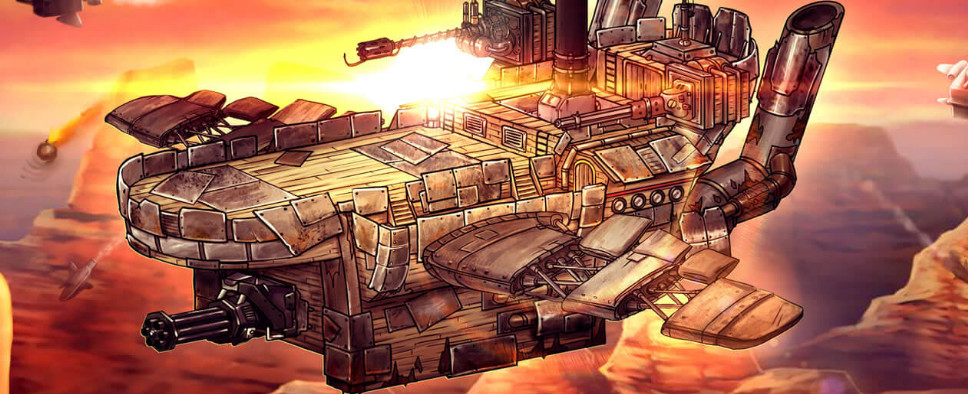-
Hits: 450
-
Written by ValH on May 17th, 2022

Article Index
Page 1 of 3
Introduction
Developed by IQ Soup, Age of Grit invites us on a Wild West adventure in a world of steampunk airships. The game is said to be inspired by classic CRPGs and Firefly, the TV series, but at first glance, it’s more akin to a story-driven FTL – a game where you control a spaceship by managing its power consumption and a variety of systems and weapons.
And whichever way you look at it, superficially, this makes Age of Grit a mighty intriguing proposition. Which is why as soon as the game graduated from early access, we took it out for a spin.
The Good, The Bad and Mostly the Bad
In Age of Grit you play as Jebediah Rockwell, a war hero who, after being dishonorably discharged, is reduced to making ends meet by smuggling assorted goods in his steam-powered airship all across The West. The West being an entire Wild West-themed continent housing three countries with plenty of bad blood between them.
The game starts with no intro or explanation. It simply places you in your private quarters where you can click on some lore-dispensing items and go through a quick tutorial. From there you can keep exploring your ship and get introduced to your crew – a pilot, a navigator, a mechanic, and a gunner.
All of these are distinct characters with their own stories and personalities, and they’re here to stay. As the game doesn’t have any sort of level or skill-based progression, you can’t upgrade them in any way.
Instead, you’ll be able to converse with them from time to time, simulating that thing that should be familiar to anyone who’s ever played a BioWare game where you occasionally go back to base and spend some time chatting up your companions.
And as for upgrades, you have your ship to consider. Its inventory is split into three distinct categories – cargo, personal effects, and gear. The first is self-explanatory. As a smuggler, you haul cargo to make a profit.
Your personal effects, on the other hand, appear to do absolutely nothing. Throughout the game, you’ll keep finding all sorts of miscellaneous items ranging from rifles and cowboy hats to compasses and piles of lumber. And you would think these items would come in handy during various events by unlocking new options. But surprisingly, this doesn’t seem to be the case. The only use for all this stuff I found was selling it for some extra cash.
Finally, there’s gear. Your ship has a hull, an engine, a sensor dish, wings, a rudder, and up to six guns. The engine is the key here, as in order to use all that other stuff, you first need to generate some steam.
This brings us to the gist of the game’s airship-driven combat system – you use your engine to generate steam, and then you spend that steam to power your weapons and sensors, which is where the whole steampunk FTL comparison comes in. Only in Age of Grit you operate your systems in a turn-based fashion.
However, the similarities here are purely superficial, as the game doesn’t have nearly enough systems to facilitate anything resembling strategic thinking. Your best strategy every time is to go all out with your guns and hope for the best. The only tactical decision you have to make is whether you should start blasting immediately or spend a turn building up your steam reserves first.
For a combat system like this to be satisfying, it needs to have at least a few extra dimensions to it, like viable defensive options allowing you to prevent damage, dynamic repairs, active crew management, that sort of thing. When just about all you can do is attack, things get old fast.
And this is a great shame, as the idea behind the game’s guns is actually pretty cool thanks to the adjustable levels of steam power you can assign to them and a great many special traits. You have guns that do extra damage when it’s the first gun that shoots in a turn. Guns that do extra damage when you pump them full of steam and do a proper burst attack. Guns that set their targets ablaze or disable crucial systems. On top of that, if you use a gun too much, it starts overheating, forcing you to switch things up.
But this alone is just not enough to carry the combat system. What’s also fairly annoying is that while the game has a combat log, it obfuscates all of its stats and rolls and just shows you the end result.
In a game like this, the bulk of the fun is looking at your stat screen and trying to figure out how much initiative you need to act faster than your enemies, how to properly counteract their evasion stat, and how much armor penetration you need to do any real damage. And this is rather hard to do when the game doesn’t have a stat screen and hides its rolls from you.
Age of Grit Review
Source: Hopefull Philippines

0 Mga Komento